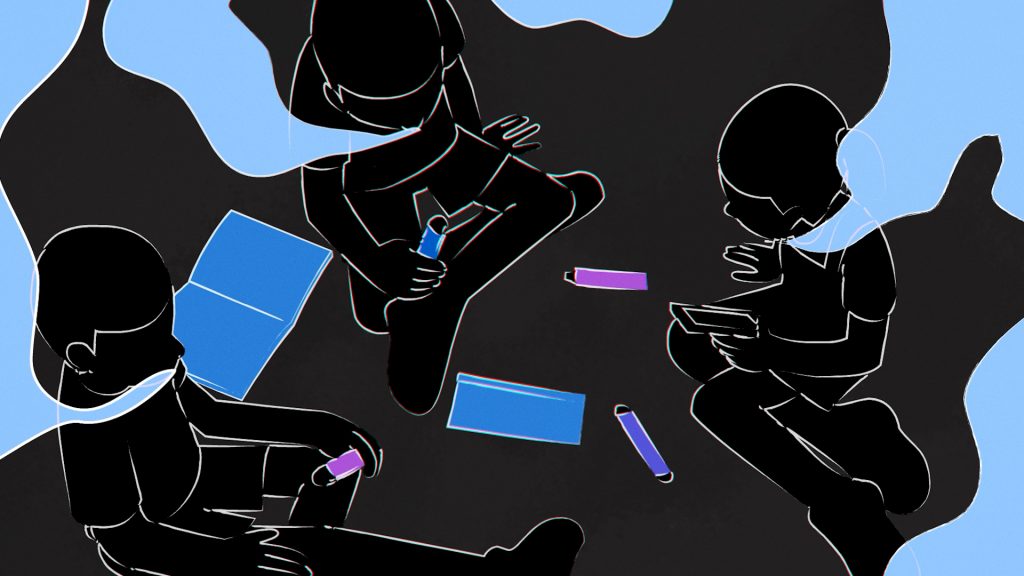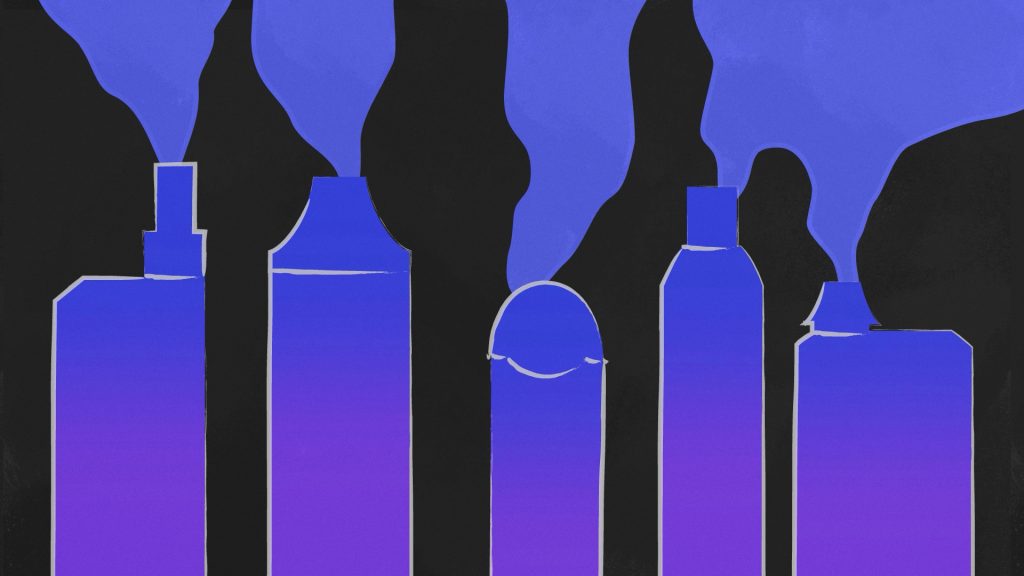All illustrations by Audrey Halim for RICE Media
A concerned parent says that he’s seen it more than once; in discreet corners of a void deck near his house, secondary school students are vaping while still in their school uniforms.
“Disposable vapes [are] left behind on the floor as well,” recounts a parent who only wanted to be identified as Marcus*. “They should definitely throw it away. Put it in the dustbin at least.”
As if this were not close enough to home, his friends have also caught their children—all of them in their early teens—vaping.
Sarah*, a student, recalls how her private tuition centre classmates would openly vape during lessons. Vaping devices, in an assortment of flavours such as iced lemon tea and grape, were passed around like candy in her classroom. During breaks, students would flock to an adjacent classroom to vape.
“[The teacher] asked them to stop, but there’s nothing he can do as well,” Sarah, 20, admits. “I think the tuition centre is quite established, so they don’t [want this to] tarnish their reputation.”
In student hostels across universities like National University of Singapore (NUS), Nanyang Technological University (NTU), and Singapore Management University (SMU), vapes are openly left among scattered notes, on communal tables, and shelves.
Whether we want to admit it or not, vaping is part of the student culture in Singapore. At this point in time, it might not be a question of how to stop people from getting their hands on vapes.
While licensed tobacco retailers ensure that only those of age can get their hands on cigarettes, it’s difficult to gatekeep vapes from youths, especially with a thriving black market. It might be a matter of implementing measures to minimise potential harm.

Are Bans Effective?
These anecdotes are part of the widespread and worsening vape epidemic in Singapore. In April this year, The Straits Times reported that the “purchase, use or possession of vapes jumped 58 percent” in 2023 from the previous year.
In October 2023, Second Minister for Education Maliki Osman revealed in Parliament that about 800 students were referred to the Health Sciences Authority (HSA) for vaping offences in 2022. This is a worrying increase—across 2018 and 2019, the total number was fewer than 50.
And these are only the students who were caught red-handed.
While the above figures represent an increase in underage vaping among Singapore’s youths, we don’t actually know exactly how many young Singaporeans have a disposable vape tucked away in a pocket or their school bag.
Ryan*, 21, was one of those Singaporean youths who engaged in underage vaping. Currently a first-year university student, he started vaping around secondary three and kicked the habit just before National Service.
“I wanted to be cool and fit in, you know,” Ryan explains. “[Vaping] was easier to get into compared to smoking because vaping tastes better. It was more accessible at the time. It was more widespread compared to smoking.”
Indeed, the draw of vaping lies in its accessibility and attractive flavours. There are countless Telegram groups dedicated to the marketing and sale of vapes—all with funky names like ‘Berry Blast’ and’ Pineapple Delight’. And as soon as one group shuts down, another opens just as quickly.
Ordering one is just as easy as taking a gander at a Google Sheet that indicates the flavours and devices in stock. Some vape dealers have even gone the extra mile, delivering bulk orders straight to buyers’ doorsteps.
With vape manufacturers constantly rolling out new brands and flavours, some see vaping as a quest to try them all—which has possibly contributed to the growing trend of vaping among students.
The fact that vaping is illegal in Singapore might be adding to the thrill of being a vaper. Offenders can be fined up to $2,000 for the possession, use, and purchase of vapes. Distributors and importers face even stiffer penalties.
Yet, it seems that the current regulatory approach can’t deter vaping among Singapore’s youths.
“I’ve had friends who got caught for vaping. The police confiscated their vapes, and they had to pay a fine,” Sarah recounts.
“Obviously, it doesn’t stop them. They get a new one.”

No Perfect Solution to Underage Vaping
There are no perfect solutions when it comes to the uphill battle against underage vaping. Countries are divided on the most effective way to protect youths from the harms of vaping.
Vaping might seem benign, but it can cause real harm, as these cheap devices could contain harmful, unregulated substances associated with lung disease. Furthermore, very few know what these unregulated vapes contain. In Singapore, a vape addict developed a rare lung disease, which is suspected to be connected to his use of vapes.
Vapes are banned in 34 countries. But those countries find themselves in the same predicament as Singapore—a growing black market and many other challenges that come with enforcing the ban.
On the other extreme, 74 countries do not have any regulations surrounding the use of vapes.
“I think a blanket ban clearly hasn’t been working because you still see vapes all around,” Marcus reflects. “I’m not saying we should put more officers on the ground to police this. Maybe a better solution here would be to find a middle ground.”
Singapore’s blanket ban on vapes is frequently compared to the regulated approach surrounding cigarettes. The government has explained the differences in these approaches.
In 2019, then-Senior Parliamentary Secretary for Health and Home Affairs Amrin Amin explained the government’s position in an article on TODAY: “The comprehensive ban is intended to protect the public from the harms of emerging tobacco products.”
“If we had our way early on, we probably would have banned cigarettes at the outset,” he explained. Mr Amrin elaborated that banning cigarettes now would be challenging given that these products are deeply entrenched globally.
Between the extremes of blanket bans and an unregulated approach, the middle ground consists of countries that allow vapes only under strict conditions.
In Australia, while relatively unsuccessful, vape policies mean that citizens need a prescription before they can use vapes containing nicotine. The European Union limits the amount of nicotine in vapes and explains that non-smokers should not use the products.
“We have essentially banned all vapes; therefore, black market products are making their way to the market. Our kids are using these black market products,” Marcus explains.
“And we don’t know what’s inside the black market products. I think that’s really the danger here.”

Lesser Evils
At first, the warning that “our kids are getting their hands on vapes” might seem like fear-mongering. However, Sarah recalls watching TikTok clips in which primary school students conceal their colourful vapes in their pencil cases, strategically timing the use of their vapes in class.
Despite the blanket ban, the black market for vapes continues to thrive. And in most countries, children are using vapes at higher rates than adults. It’s a poignant reminder that while enforcement efforts against users are crucial, the true battle lies in dismantling the sources. In this endeavour, traditional law enforcement agencies such as the Singapore Police Force (SPF), Customs, and Immigrations and Checkpoints Authority must shift their gaze from users to the source of the issue: illegal smuggling.
Given the current situation, we may need alternative strategies that better address the realities of the underground vape market. It’s a choice between lesser evils: Testing and regulating vapes for relatively safer consumption or banning them and forcing people to the black market.
Existing measures—including public campaigns in schools and increased enforcement at our borders—seem to show limited effectiveness, after all. We don’t know if these measures are effective either, because there are no official studies that dive into the habits of the local market.
If anything, traditional law enforcement agencies with the necessary expertise should do more to tackle the source of the issue.
“It’s not like vaping is completely risk-free. At the end of the day, you are inhaling something into your lungs that shouldn’t be there.” Marcus ponders.
However, he does concede: “I think there could be some sort of discussion around regulating these products in a risk-controlled manner.”
Until then, Marcus can almost be certain that secondary school students, with their disposable vapes in hand, will continue to be a common sight at his nearby void deck.
* Names have been changed to protect their identity






